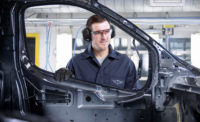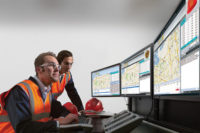Real-time tracking & monitoring for a smart safety environment

What’s the connected worker? Like the connected home we’re hearing so much about, the connected worker is workplace equipment (tools, PPE, vehicles) outfitted with sensors to track and report data. The data, transmitted remotely (via the cloud) or directly through docking systems, monitor equipment performance, usage or environmental factors to enhance worker safety and processes (servicing) in place to support it.
Readers may be familiar with connected products (gas detectors servicing alerts) that have been around for many years. This article identifies common connected technology terms, concepts and uses that will be new to a workplace safety environment.
Wearables
Day to day consumer devices such as a Fitbit, smartwatch, heart rate monitor, or medical monitoring device have been around for many years and introduced us to the power of personal real time tracking. A few manufacturing companies are launching a comprehensive platform to track safety equipment on site or across the company. Some are also looking at an agnostic system that registers multiple-manufacturers and provides a flexible system for employers to keep track. Safety clothing and shoes are embedding temperature sensors and biometric monitoring. A European company has launched safety glasses with data capability.
IoT (The Internet of Things)
IoT is the networking of physical devices, with embedded sensors that have the capability to connect and exchange data through the internet to a cloud platform and potentially accessed via computers or mobile devices. Complex and sci-fi? Security alarms and home thermostat systems are managed and tracked by consumers on their phones. For the workplace, IoT can provide staff and employers with a deeper insight into workers safety, compliance and equipment to reduce workplace accidents or illness.
Sensors/Smart sensors
Along with widespread access to the internet, Bluetooth and smart phones, sensor technology has really accelerated in the last few years. Smart phones and fitness monitors have leveraged miniaturization to read temperature, movement and even heart rate. Equipment sensors are the field soldiers; the hardware doing the heavy lifting of monitoring processes, taking measurements and collecting data.
Today, sensors gather and disseminate critical local information in a way that we have not had access to in the past. The rapid decrease in sensor price has enabled companies to innovate every day products (like the refrigerator and the car). Infrared sensors, reading heat and leaks, are safely and easily connected to wearable devices.
Other sensors include motion, velocity, position, force, shock and vibration sensors. This array of sensors communicates directly via an even wider range of technologies: Bluetooth, WiFi, Zigbee, Z-Wave or other infrared systems. Technical personal equipment where workers lives are at risk are re-imagined - sensor embedded respirators prompt the wearer to complete their safety check recorded to their mobile device location, re-enforcing best operating procedures and ensuring protection and peace of mind. And should the system record a change in use (equipment failure or use) an alarm could go off on a supervisor’s or co-worker’s mobile device alerting and initiating action to assist. In time-critical events, quick responses from the team are imperative.
BioMetrics
Biometrics is the technical term for body measurements and calculations. Health and fitness systems have meant most people are familiar with their own biometric data such as weight, temperature or heart rate. In the workplace, biometric data has the potential to make people more comfortable (reduce heat stress), more productive (better designed shoes/clothes) or safer (by monitoring heart or breathing rates) These smart products are coming and with greater use and deployment, will change the way we think about our personal safety at work.
The current opportunities for a connected workplace are huge and we are already seeing these advancements such as in gas detection systems that provide critical exposure data, lifecycle information, and equipment monitoring remotely to the safety manager. Connected safety equipment has the potential to eliminate costly paperwork, dramatically improve compliance, enable more effective training as well as deliver on- demand equipment maintenance – reducing costs and improving productivity while ensuring workers are home safe and healthy.
Challenges ahead
This all sounds good, so what are the challenges for connectivity?
With all new technologies there is an adoption curve as employers become aware and workers and managers accept the new technology. The worker could imagine being watched rather than feeling protected. Could the new technology attract union or labor issues? Does the new connected safety equipment pricing deter business investment regardless of the medium- to long-term savings?
Currently the major challenge being seen in the smart home market is a unified platform for cloud-based and mobile applications. Imagine a business with fall protection harness from company A, gas detection units (Brand B) and respirators (Brand C) all with their own mobile apps. The worker will be required to do safety checks with three apps and consequently his supervisor or company has to monitor three different cloud based applications. Alternatively, major safety equipment manufacturers are offering to meet all the PPE needs on a single platform/app. One company with one brand of PPE is not practical, especially when you involve subcontractors.
After all of this, at the heart of the connected worker is an important theme – safety and health in our workplaces. Safety equipment manufacturers are investing in innovation that improves employers’ ability to deliver better PPE, more widely and more effectively. Workers can feel improved safety with tracking and equipment performance monitoring. The smart workplace is more than slapping a sensor into a piece of safety equipment. It is driving a connected and real time system that has the potential to optimize site safety management and worker engagement. It’s an exciting time with great opportunities.
Looking for a reprint of this article?
From high-res PDFs to custom plaques, order your copy today!








